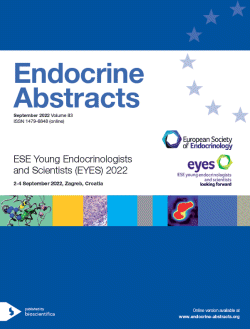
ESE Young Endocrinologists and Scientists (EYES) 2022
Zagreb,
Croatia
02 Sep 2022 - 04 Sep 2022

ESE Young Endocrinologists and Scientists (EYES) 2022
Endocrine-related Cancer
ea0083erco1 | Endocrine-related Cancer | EYES2022
Tumor suppressor role of RBM22 in prostate cancer acting as a dual-factor regulating alternative splicing and transcription of key oncogenic genes
A. J. Montero-Hidalgo , P. Saez-Martinez , A. Sarmento-Cabral , A. S. De la Rosa-Herencia , R. Sanchez-Sanchez , T. Gonzalez-Serrano , E. Gomez-Gomez , M. D. Gahete , R. M. Luque , J. M. Jimenez-Vacas
ea0083erco2 | Endocrine-related Cancer | EYES2022
Ablation of Znrf3 & Trp53 induces metastatic adrenocortical carcinoma in mice
J. Wilmouth JR , J. Olabe , L. Landwehr , L. Pucheu , D. Dufour , F. Roucher-Boulez , C. Lucas-Rodrigues , D. Garcia-Garcia , C. Damon-Soubeyrand , M. Kroiss , M. Fassnacht , A. Lefrancois-Martinez , A. Martinez , P. Val
ea0083erco3 | Endocrine-related Cancer | EYES2022
Hypothalamus-pituitary-adrenal axis recovery after adjuvant mitotane treatment in patients with adrenocortical carcinoma - a retrospective study
A Barac Nekic , K Zibar Tomsic , L Sambula , I. D. Vodanovic , T. Dusek , D. Kastelan
ea0083erco4 | Endocrine-related Cancer | EYES2022
Efficacy and safety of radiation therapy in advanced adrenocortical carcinoma (ACC)
O Kimpel , P Schindler , L Schmidt-Pennington , B Altieri , F Megerle , R Steenaard , J Pittaway , M Quinkler , K Mai , M. Kroiss , B Polat , M. Fassnacht
ea0083erco5 | Endocrine-related Cancer | EYES2022
PD-1, PD-L1 and CTLA-4 immune checkpoint expression – Is there a prognostic impact on adrenocortical carcinoma?
L Landwehr , I Sbiera , B Altieri , H Remde , S Kircher , S. Sbiera , M. Kroiss , M. Fassnacht
ea0083erco6 | Endocrine-related Cancer | EYES2022
Outcome of immuncheckpoint inhibitor therapy in adrenocortical carcinoma – A multicenter retrospective study
H Remde , L Schmidt-Pennington , M Reuter , L Landwehr , M Jensen , H Lahner , K Laubner , J Schreiner , J Bojunga , S Kircher , A Pohrt , M. V. Teleanu , D Hubschmann , A Stenzinger , H Glimm , S Frohling , M Fassnacht , K Mai , M. Kroiss
ea0083ercp1 | Endocrine-related Cancer | EYES2022
Synchronous eutopic and ectopic papillary thyroid carcinoma
M. L. Guia Lopes , C Saraiva , C Antunes , E Silva , C Limbert , M Chorao , L Viana Fernandes , J Sequeira Duarte
ea0083ercp2 | Endocrine-related Cancer | EYES2022
A case of primary squamous cell carcinoma of the thyroid gland
A Babayeva , O Sutcuoglu , M Coskun , A Uzun , A Inan , K Dikmen , O Yazici , M. M. Yalcin , A. E. Altinova
ea0083ercp3 | Endocrine-related Cancer | EYES2022
Raising awareness for primary thyroid angiosarcoma – a rare diagnosis not to be missed
N Chelaru , I Puscasu , A. F. Florescu
ea0083ercp4 | Endocrine-related Cancer | EYES2022
Impact of androgen deprivation therapy on the bone and metabolic changes in men treated for localized prostate cancer
L Tonkic , T Milicevic Milardovic , A Novak , J Nazlic
ea0083ercp5 | Endocrine-related Cancer | EYES2022
An exceptional case of a papillary thyroid carcinoma arising within an ovarian teratoma
D Pop Gjorceva , S Stojanoski , N Manevska , Lj Batkoska



